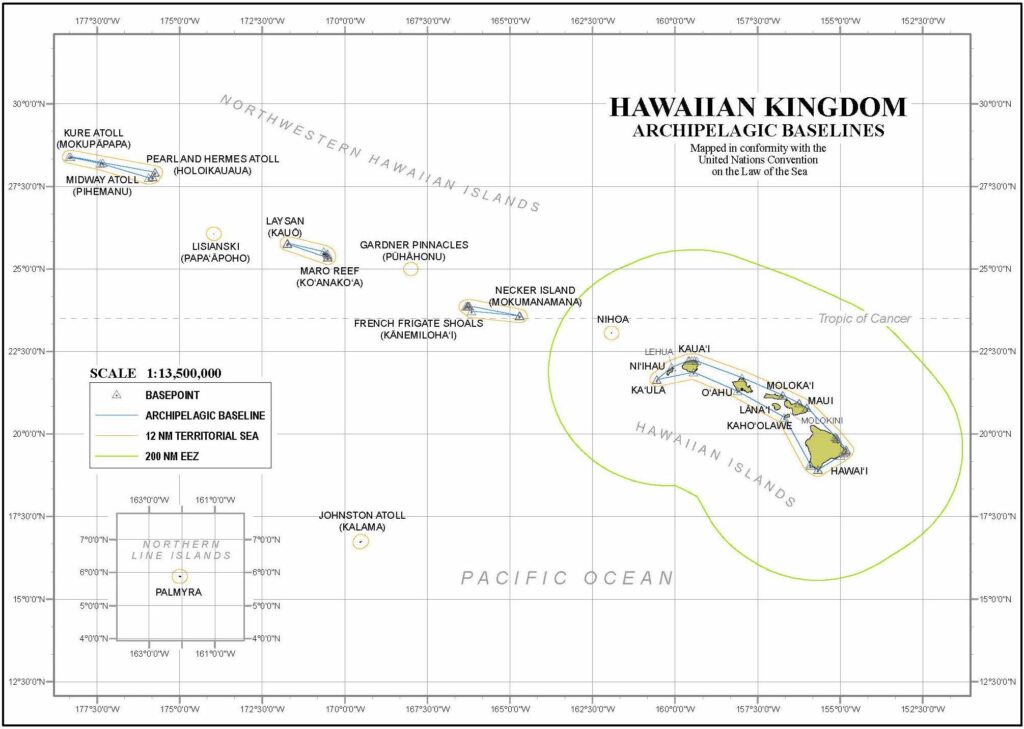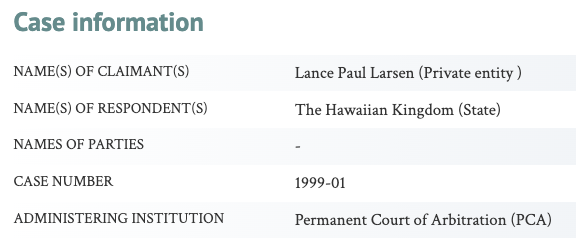There is a common misunderstanding among the world that Hawai‘i is the 50th state of the American union. The historical and legal revealing of evidence that Hawai‘i is not the 50th state, but rather the continued existence of the Hawaiian Kingdom as an independent State, has shattered this belief for those who have come to know. To better understand the why, here is the history of the formation of the 49 States of the American union that many don’t know.
All 49 states of the American union were acquired through international law because these territories were formerly the territories of other independent States. The first 13 states, which were formerly British Crown colonies, were acquired from the British Crown by the 1783 Treaty of Paris that brought the revolution to an end. Article I provided, “His Brittanic Majesty acknowledges the said United States, viz., New Hampshire, Massachusetts Bay, Rhode Island and Providence Plantations, Connecticut, New York, New Jersey, Pennsylvania, Delaware, Maryland, Virginia, North Carolina, South Carolina and Georgia, to be free sovereign and Independent States; that he treats with them as such, and for himself his Heirs & Successors, relinquishes all claims to the Government, Propriety, and Territorial Rights of the same and every Part thereof.”
In 1789, as a result of the federalist movement, these 13 sovereign and independent States collectively gave their independence to the federal government, which came to be known as the American union. These states held what was referred to as residual sovereignty but no longer retained independence. The instrument that formed this union was the federal constitution. Prior to this consolidation, these independent States were in a loose union called a confederacy according to the terms of the 1777 Articles of Confederation.
The other states of the union were formed out of territories acquired by the federal government through international treaties, with the exception of Hawai‘i, which was unilaterally annexed by a congressional statute in 1898.
There is also a common misunderstanding that the State of Texas came about as a result of a joint resolution of Congress in 1845. The truth of the matter is that this congressional action is what sparked the Mexican-American war in 1846. The State of Texas was on Mexican territory and not United States territory. In the 1848 Peace Treaty of Guadalupe Hidalgo that ended the war, the new border between the two Republics began from the Gulf of Mexico along the Rio Grande river, which is the southern border of the State of Texas, then by a surveyed boundary line that runs along the southern borders of what are now States of New Mexico, Arizona and California. Article V of the 1848 Treaty of Guadalupe Hidalgo states:
The boundary line between the two Republics shall commence in the Gulf of Mexico, three leagues from land, opposite the mouth of the Rio Grande, otherwise called Rio Bravo del Norte, or Opposite the mouth of its deepest branch, if it should have more than one branch emptying directly into the sea; from thence up the middle of that river, following the deepest channel, where it has more than one, to the point where it strikes the southern boundary of New Mexico; thence, westwardly, along the whole southern boundary of New Mexico (which runs north of the town called Paso) to its western termination; thence, northward, along the western line of New Mexico, until it intersects the first branch of the river Gila; (or if it should not intersect any branch of that river, then to the point on the said line nearest to such branch, and thence in a direct line to the same); thence down the middle of the said branch and of the said river, until it empties into the Rio Colorado; thence across the Rio Colorado, following the division line between Upper and Lower California, to the Pacific Ocean.
If Texas was annexed in 1845, then the boundary would not have begun from the Gulf of Mexico, but rather from the surveyed boundary line that would have begun from the mid-southern border of what is now the State of New Mexico, which is adjacent to the city of El Paso, Texas. From El Paso, the Rio Grande river goes north into the State of New Mexico.
In 1988, the Department of Justice’s Office of Legal Counsel (OLC) published a legal opinion regarding the annexation of Hawai‘i. The OLC’s memorandum opinion was written for the Legal Advisor for the Department of State regarding legal issues raised by the proposed Presidential proclamation to extend the territorial sea from a three-mile limit to twelve miles. The OLC concluded that only the President and not the Congress possesses “the constitutional authority to assert either sovereignty over an extended territorial sea or jurisdiction over it under international law on behalf of the United States.” As Justice Marshall stated, “[t]he President is the sole organ of the nation in its external relations, and its sole representative with foreign nations,” and not the Congress.
The OLC also stated, “we doubt that Congress has constitutional authority to assert either sovereignty over an extended territorial sea or jurisdiction over it under international law on behalf of the United States.” The OLC then concluded that it is “unclear which constitutional power Congress exercised when it acquired Hawaii by joint resolution. Accordingly, it is doubtful that the acquisition of Hawaii can serve as an appropriate precedent for a congressional assertion of sovereignty over an extended territorial sea.”
That territorial sea referred to by the OLC was to be extended from three to twelve miles under the 1982 United Nations Law of the Sea Convention. In other words, the Congress could not extend the territorial sea an additional nine miles by statute because its authority was limited up to the three-mile limit. Furthermore, the United States Supreme Court, in The Apollon, concluded that the “laws of no nation can justly extend beyond its own territories.”
Arriving at this conclusion, the OLC cited constitutional scholar Professor Willoughby, “The constitutionality of the annexation of Hawaii, by a simple legislative act, was strenuously contested at the time both in Congress and by the press. The right to annex by treaty was not denied, but it was denied that this might be done by a simple legislative act. …Only by means of treaties, it was asserted, can the relations between States be governed, for a legislative act is necessarily without extraterritorial force—confined in its operation to the territory of the State by whose legislature enacted it.” Professor Willoughby also stated, “The incorporation of one sovereign State, such as was Hawaii prior to annexation, in the territory of another, is…essentially a matter falling within the domain of international relations, and, therefore, beyond the reach of legislative acts.”
Under international law, what was illegally overthrown on January 17, 1893, was the Hawaiian Kingdom government and not the Hawaiian Kingdom as an independent State. International law distinguishes between the independent State and its government. For one State to acquire the territory of another State there needs to be a treaty like the United States treaty of cessions with Great Britain, France, Mexico, Russia and Spain. When the United States unilaterally annexed Hawai‘i by a congressional joint resolution in 1898, the act was no different than Iraq unilaterally annexing Kuwait in 1990 during the First Gulf War, or Nazi Germany unilaterally annexing Luxembourg during the Second World War. Both were illegal under international law and so is the annexation of Hawai‘i.

In 1997, the Hawaiian government was constitutionally restored by a Council of Regency that serves in the absence of the Monarch. Two years later, both the Hawaiian Kingdom, as a State, and the Council of Regency, as its government, was acknowledged in 1999 by the Permanent Court of Arbitration in The Hague, Netherlands, in Larsen v. Hawaiian Kingdom.




The Hawaiian Kingdom was never a part of the 50 the State of the United States.
You’re right. But the Republic, Territory and State of Hawaii is…it’s just fraud by word play.
Mahalo bradah Lopaka but actually there is no government. It’s brainwashing the people to make them believe That there is a government. That is why they always making NEW LAW’S and passing it. Don’t you see it ? ALOHA!!!🤙
I respectfully disagree. There is a government but it is criminal in nature and it’s cause is to pillage and plunder via fraud. It is a corruption of our monarchy and is styled as “State of Hawaii.” And we know this yet still all are bounded by the social contract, not a theory. Generations today are pledged to the US for the privileges and benefits to live as US citizens in there ancestral homelands. So therefore we are not brainwashed as much as we did not do the homework to know the systems, procedures, rules, regulations, etc which govern our lives today, we’ll maybe only the ones that can benefit us or help us survive. Most simply do not have the backbone to stand on what our ancestors has laid before us and rather play in the Federal sandbox where at least they have a share in something rather than not have nothing but have to fight for everything. Who are we? This is the truth which most need to hear.
Mahalo for sharing that info… It really helps to put things in perspective.
Even with these historical facts been presented, Judge Kobayashi along with the rest of the Judicial system still chooses to play STUPID. Talk about corruption… And the lie continues….
Where’s the treaty of annexation? The congress of the US has not authority outside their jurisdiction. It’s always an eye-opener!
They only have authority within their jurisdiction via your ens legis identity (social contract theory via social security) as a resident of their ens legis government and people (republic/territory/state of Hawaii & residents).
“MAHALO, MAHALO A NUI LOA”,…… for sharing with Us, your Tireless Research, Strong Committments, and Dedication to ALL of our HAWAIIAN SUBJECTS, and to ALL multi-ethnic groups of the World, the TRUE 49th State—-(not-the-50th state,) SOVEREIGN STATE since 1843 til through International Law…. by receiving recognition through our Three IMPORTANT Delicates, TIMOTEO HA’ALILIO, WILLIAM RICHARDS and SIR GEORGE SIMPSON….have shown to us their patriotism, loyalty and love to their 49th country/state, the Hawaiian Kingdom and deep respect toward their King III. UA MAU KE EA O KA AINA I KA PONO= the life of the land is perpetuated in righteousness. The Hawaiian Kingdom LIVES FOREVER …that concludes our KUPAU OHANA hearts and souls…..to those of the past and the present to DR.DAVID KEANUI SAI, the Council of Regency AND to every hawaian subjects and Multi-ethnicity for TRUTH and JUSTICE
Mahalo Keanu and Council of Regency. This is clarity and confirmation. We are free when we know the facts and in inner ways we can turn our puuwai canoe homeward to shore and landing with confidence. I’m so pleased to feel the strength of your words. Let’s share this. Everyone needs to see this and feel it.